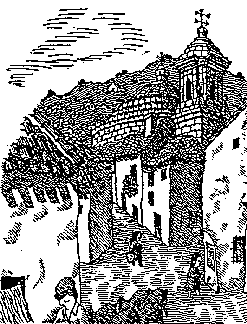JAMÓN, JAMÓN By Lawrence BohmeForeigners may rave about that fragrant paella washed down with a creamy gazpacho, but food-wise there's only one thing that Spaniards REALLY care about and that's jamon. There was even a highly entertaining (albeit politically incorrect) film made about it with the title I have borrowed for my essay! The plain truth is that nothing else Spaniards eat is much more than a complement for the platter of mountain cured ham - jamón serrano - which arrives at the table or bar counter like a bowl of priceless caviar. On the rare occasions when burglars strike the farmhouses in the hills of Montefrío, they always head straight for the loft where the hams are drying; in fact, whenever the family down the road from me is invited to a wedding or a christening, one member always stays home to protect the jamones, just in case.In Montefrío we eat the glorious stuff almost raw - cured for less than a year - when it's still pink and soft and sweet; in that state, it reminds me of tuna fish sashimi, which happens to be the only thing I like as much as jamón serrano! But the great name hams - the "designated appellation hams", if you wish - such as jabugo and pata negra are cured to a marbled black-red colour and offer much more refined pleasures to the palette. Unfortunately they are so expensive that I only ever get to eat them when I'm interpreting at some conference where I'm invited to the 4- star buffet; but a well-off Spaniard thinks nothing of spending over $300 on a pedigreed ham. Most of the commercially sold hams are currently made in
factories with special cold rooms for the curing process; but in the villages where each
family makes its own, things are still done the natural way, with vastly superior results.
To begin with, the pigs used for commercial ham are raised to be lean, because all of
their meat except the hind legs will be sold in butcher shops and eaten fresh; whereas, as
every self-respecting andaluz knows, the best ham is always the one which has the thickest
layer of fat. Every farmhouse has its cámara, a room in the attic with barred, unglazed windows that let the cold winter air blow through; the hams are rolled in salt on a table called the saladero and left there for several weeks. Then all the salt is washed away and they are hung from the rafters to cure, or "dry": the whole objective is to cure them with the minimum amount of salt, since the meat should be sweet in taste. About one out of every five hams are lost this way, although this is only discovered when the curing process is over and the leathery crust around them is pierced for the final examination, with a long splinter of cow-bone; a quick whiff of the bone after removal is enough to tell if the ham has cured or spoiled. When I rebuilt my cortijo I turned my cámara into a bedroom and the saladero into a double bed, but every year in December I am invited to my neighbour's down the path, to take part in the year's most joyous - and perhaps most useful - event, evocatively known as La Matanza. Surely, only in Spain could a party be called "The Killing", although I always get there well after the execution of the pigs, which occurs at dawn. All the neighbours and relatives take part, and a special man is assigned the solemn task of pinchar-ing, or "sticking" the pig. In fact, no one ever says "Tomorrow we're going to kill (matar) the pig", but "Mañana vamos a pinchar el marrano", which, to my ear, sounds more like teasing the pig rather than putting it to death. By the time I arrive the carcasses are hanging from an oak tree and the women are busy stuffing sausage around a long wooden trough. With their sleeves rolled up and their arms coated in blood, they knead the mash of onions, flesh and blood until it is ready to be stuffed into a large tin syringe-like device called la maquina, which one of them braces against her shoulder and pumps, while another holds the empty intestine over the nozzle to receive the filling. What with the red flesh slithering into the transparent sheath of the intestine, the vigorous pumping and the women's grins and cackles, there is something unmistakably sexual about the whole scene, which is the subject of many raucous jokes as the operation proceeds. The work is followed - rewarded, rather - by a sumptuous meal in the farmhouse; the women file into one room and the men into another to be served a banquet lunch in an atmosphere of ritual seriousness. Since I usually turn up with an assortment of foreigners of both sexes, the diplomatic impasse is quietly solved by serving us at a table of our own under the grapevine of the patio. When I explained to a village friend that many of the British people who come to stay in my holiday cottages do not eat ham because they are vegetarians, he looked astonished and scoffed, "That's because in England they don't have our 'marranos'!". To get back to sex, it was a bit as if I had said that a given Englishman leads a life of voluntary celibacy, to be pityingly told that this is simply because in his country there are no hot-blooded Andalusian women... Favorite Spanish Recipes | Mas recetas de España | More Spanish Stories |
